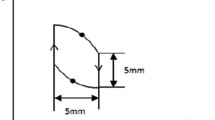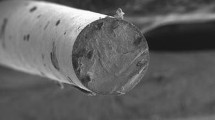Abstract
Invar alloy is important material used for the OLED (Organic light emitting diode) shadow-mask in the mobile display industry due to its characteristics of smallest thermal expansion coefficient. Consumers in modern society demand higher display resolution. Electrochemical machining is one of the methods for obtained these high-resolution requirements. Electrochemical machining is a non-contact method that has advantages regarding defects like thermal strain and micro burrs compared to other non-conventional machining methods. For precision electrochemical machining using different shape electrodes, the current density should be controlled precisely. The purpose of this study is to apply the FEM (Finite elements method) analysis in order to investigate the current density in the electrochemical machining. And the current density distribution between invar alloy and electrode are carried out with shape electrode type and micro array film type under the same conditions by simulation methods. FEM analysis results show that using shape electrode type, current density distribution is very concentrated. And also by micro array pattern film, desired current density which is needed for electrochemical machining could be obtained easily. More precise electrochemical machining can be available by controlling the current density between the suitable type and invar alloy.
Similar content being viewed by others
References
K. Xu, Y. Zeng, P. Li, X. Fang and D. Zhu, Effect of wire cathode surface hydrophilia when using a travelling wire in wire electrochemical micro machining, Journal of Materials Processing Technology, 235 (2016) 68–74.
C. Xuezhen, X. Zhengyang, Z. Dong, F. Zhongding and Z. Di, Experimental research on electrochemical machining of titanium alloy Ti60 for a blisk, Chinese Journal of Aeronautics (2015).
M. J. Shin, S. Y. Baek and E. S. Lee, A study for improving surface roughness and micro-deburring effect of nitinol shape memory alloy by electropolishing, Transactions of the Korean Society of Machine Tool Engineers, 16 (6) (2007) 49–54.
R. Schuster, V. Kirchner, P. Allongue and G. Ertl, Electrochemical Micromachining, Science, 289 (2000) 98–101.
E. G. Finantu-Dinu, D. Korzec, M. Teschke and J. Engemann, Influence of the electrode layout on performance of insulated surface discharge: Electrical characterization, Surface and Coating Technology, 174–175 (2003) 524–529.
X. Chen, N. Qu, H. Li and Z. Xu, Electrochemical micromachining of micro-dimple arrays using a polydimethylsiloxane (PDMS) mask, Journal of Materials Processing Technology, 229 (2016) 102–110.
G. Q. Wang, H. S. Li, N. S. Qu and D. Zhu, Investigation of the hole-formation process during double-sided through-mask electrochemical machining, Journal of Materials Processing Technology, 234 (2016) 95–101.
S. Huang, X. Zhang, M. Tafu, T. Toshima and Y. Jo, Study on subway particle capture by ferromagnetic mesh filter in nonuniform magnetic field, Separation and Purification Technology, 156 (2005) 642–654.
A. Munir, Z. Zhu, J. Wang and H. S. Zhou, FEM analysis of magnetic agitation for tagging biomolecules with magnetic nanoparticles in a microfluidic system, Sensors and Actuators b, 197 (2014) 1–12.
X. Fang, N. Qu, Y. Zhang, Z. Xu and D. Zhu, Effects of pulsating electrolyte flow in electrochemical machining, Journal of Materials Processing Technology, 214 (2014) 36–43.
Author information
Authors and Affiliations
Corresponding author
Additional information
Recommended by Associate Editor Taesung Kim
Eun-Sang Lee received B.S. and M.S. degrees in Mechanical Engineering from Inha University in 1985 and in 1987. Dr. Lee received a Ph.D. from the Korea Advanced Institute of Science and Technology in 1998. Dr. Lee is currently a Professor at the School of Mechanical Engineering at Inha University in Incheon, Korea. His research fields are in ultraprecision manufacturing, electrochemical micromachining and the development of a semiconductor wafer polishing.
Rights and permissions
About this article
Cite this article
Choi, SG., Kim, SH., Choi, WK. et al. A study of the current density analysis for two type method on the invar alloy in electrochemical machining. J Mech Sci Technol 31, 4345–4351 (2017). https://doi.org/10.1007/s12206-017-0833-6
Received:
Revised:
Accepted:
Published:
Issue Date:
DOI: https://doi.org/10.1007/s12206-017-0833-6




